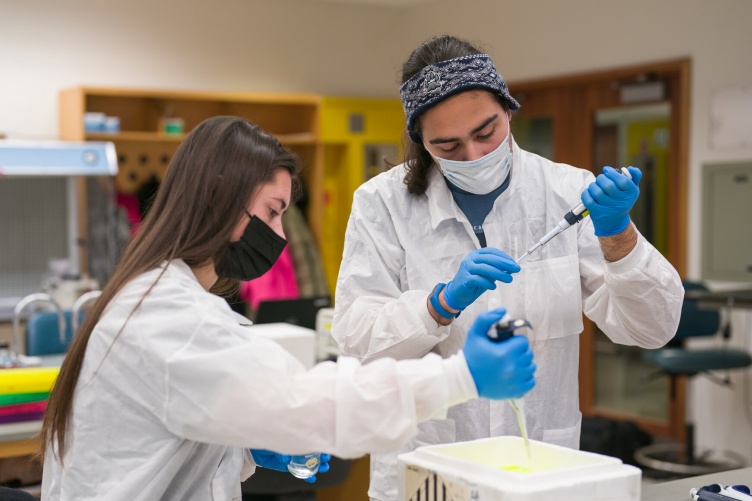
It isn’t often that an entire class of undergraduate students has an opportunity to fill a scientific knowledge gap that may eventually lead to the design of better drugs or treatment strategies. But this year, a group of students in COLSA’s Molecular Biology Research Methods course (BMCB 754/BCHM 854) did just that.
They engineered a set of molecular “tools” that will help researchers better understand how selective serotonin reuptake inhibitors (SSRIs), which are widely prescribed to treat conditions such as depression, bipolar-disorder, schizophrenia, OCD and ADHD, work — and what can be done to improve their efficacy.
Serotonin, a chemical substance the body naturally produces, regulates mental and physical functions including sleep, metabolism, brain function, mood and emotion. Alterations in the body’s levels of serotonin — commonly called the “happy chemical” — are associated with mental health disorders.
“Engineering the tools for pharmacological experiments requires a complementary skill set — and hard work. Our dedicated student team has demonstrated why collaboration is so valuable in science.”
The story of how the students came to contribute to this valuable science begins at Disneyland in California. Cheryl Whistler, professor of molecular, cellular and biomedical sciences, was standing in line with her sister Jennifer Whistler, professor of physiology and membrane biology and the associate director of the Center for Neuroscience at University of California, Davis, and listening to her describe a hypothesis she had about how SSRIs work.
“In theory, SSRIs improve symptoms because they increase serotonin levels,” says Jennifer Whistler. “However, while serotonin levels rise within two hours of SSRI administration, it takes 4 to 8 weeks for SSRIs to ameliorate symptoms. This suggests that the mechanism-of-action of SSRIs is more complicated than simply increasing serotonin levels.”
She posited that SSRIs work by rebalancing the types of serotonin receptors that are present to sense and respond to serotonin. But she didn’t have the tools to test her theory.
Then Cheryl Whistler had an idea: she proposed a collaboration with her students to build the necessary tools in class. Back on campus, she charged her students with creating unique plasmids, small pieces of DNA that would “tag” each of 21 different human serotonin receptor proteins so they could be easily visualized. When each plasmid is introduced into a target cell, the tag allows the serotonin receptor’s pattern of movement to be precisely mapped through time: from the outside surface where they sense serotonin into cells where they are either destroyed or recycled back to the surface. This would allow Jennifer Whistler’s research team to determine if and how the balance of receptors changes with different SSRI therapies.
“Remarkably, there is very limited knowledge regarding how serotonin alters the trafficking of serotonin receptors, and we will use the plasmids created by the UNH students to provide this knowledge,” says Jennifer Whistler. “Our goal is to inform novel approaches to serotonin therapeutics designed to rebalance serotonin signaling.”
“Brain chemistry is very complex, and the job of basic researchers, such as college professors, is to sort through information, identify what is missing, and design experiments needed to produce useful knowledge,” adds Cheryl Whistler. “Engineering the tools for pharmacological experiments requires a complementary skill set — and hard work. Our dedicated student team has demonstrated why collaboration is so valuable in science.”
Her students agree.
“This was a unique opportunity for me to do work in class that will directly help the research of other scientists, including our collaborator at UC Davis who will use it to conduct research that will elucidate serotonin receptor regulation,” says Faith Vachon ’22. “We had a hand in creating a very valuable toolbox, and I know that not everyone gets to experience something like this in their undergrad years, so I am very excited and grateful to have been a part of it.”
The students also developed a generic set of molecular tools that can help track what happens to any protein in a cultured mammalian cell. The basic tools the students produced as a team, which Cheryl Whistler describes as broadly useful for a variety of research, can be used to elucidate any disease or process that involves the movement, localization or interaction of proteins in cells.
“This project has helped me connect molecular and cellular biology concepts with a real-world application project,” says Alicia McCarthy ’22G, a student in the molecular and cellular biotechnology (MCBT) master’s program. “The MCBT program is only a year long, but I have gained so many skills in my first semester that I can add to my resume due to this experience.”
Cheryl Whistler plans to deposit the plasmid toolboxes with a non-profit plasmid repository so they are available to any researcher. All 15 students in her class will be credited as co-inventors. She is also co-authoring a paper describing the toolbox with MCBT students McCarthy, Gabriella Palermo ’23G and Jordan Torpey ’23G. The manuscript will be submitted for peer review publication.
"Being able to co-author a paper is both humbling and empowering,” says Torpey. “I was surrounded by so many brilliant minds this past semester, which encouraged me to keep reaching my potential. I cannot wait to continue building tools in the molecular biotechnology field that compliment other scientist and their studies."
For Cheryl Whistler, the entire collaboration has yieldsed noteworthy achievements all around.
“It is exciting that what our students built will provide information and fill a knowledge gap that may eventually allow design of better drugs or treatment strategies,” she says. “And it’s great that while learning techniques and theory, they are also contributing to really important science.”
-
Written By:
Sarah Schaier | College of Life Sciences and Agriculture

















































